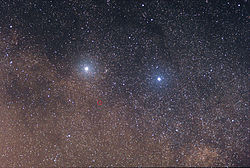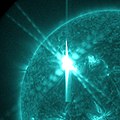The expanding photosphere method (EPM) is a method used to measure distances to Type II supernovae. It was developed by Robert Kirshner and John Kwan in...
5 KB (589 words) - 18:36, 2 May 2025
Sun (redirect from Solar photosphere)
the Solar System. The mass of outer layer of the Sun's atmosphere, its photosphere, consists mostly of hydrogen (~73%) and helium (~25%), with much smaller...
173 KB (19,378 words) - 03:23, 29 June 2025
kilonova, the optical afterglow of a neutron star merger, using the expanding photosphere method. Due to the blackbody nature of early kilonova spectra, such...
132 KB (13,177 words) - 05:27, 15 June 2025
(Research Notes) 275: 630. Schmidt, B. P., et al. (1994). "The Expanding Photosphere Method Applied to SN1992am at cz = 14600 km/s". Astronomical Journal...
95 KB (9,231 words) - 16:01, 26 June 2025
known as the geometric Baade–Wesselink method. A closely related technique is the expanding photosphere method, which can be used to determine the distance...
3 KB (308 words) - 19:34, 15 February 2025
a visual magnitude of 13.3. Using a corrected version of the expanding photosphere method (EPM), the distance to the supernova is estimated as 37.5 ± 3...
17 KB (1,372 words) - 16:25, 1 July 2025
International Space Station payload Evolved psychological mechanism Expanding photosphere method EPM (cycling team), a Colombian cycling team Eastport Municipal...
2 KB (199 words) - 19:48, 15 February 2025
providing data for a Hubble diagram of Type II supernovae using the expanding photosphere method. In 1994, the Calán/Tololo team formed a parallel project, the...
5 KB (598 words) - 19:42, 15 February 2025
The photosphere denotes those solar or stellar surface layers from which optical radiation escapes. These stellar outer layers can be modeled by different...
11 KB (1,349 words) - 01:00, 5 December 2021
distances to Type II supernova in the Hubble flow using the Tailored Expanding Photosphere Method. 2007: Gruber Prize in Cosmology (co-recipient with High-z Supernova...
3 KB (320 words) - 19:44, 15 February 2025
light-years wide. Betelgeuse became the first extrasolar star whose photosphere's angular size was measured in 1920, and subsequent studies have reported...
178 KB (18,821 words) - 04:30, 27 June 2025
measure geometric distances using the expanding photosphere method (EPM). With Pinto, he invented a semi-empirical method to measure distances to Type II events...
7 KB (589 words) - 20:21, 15 February 2025
symmetric). This method works only if the supernova is close enough to be able to measure accurately the photosphere. Similarly, the expanding shell of gas...
56 KB (7,318 words) - 23:10, 5 June 2025
Star lifting (section Methods for lifting material)
skims over the surface of a star just before dipping below the star's photosphere to scoop in plasma using its retractable collectors. In the Star Wars...
12 KB (1,814 words) - 23:38, 13 April 2024
Coronal mass ejection (category Articles to be expanded from April 2023)
rise to the Sun's surface—the photosphere—where they may form localized areas of highly concentrated magnetic flux and expand into the lower solar atmosphere...
58 KB (6,838 words) - 23:59, 13 June 2025
years. It has expanded somewhat to a size 4.4 that of the Sun and emits 44 times as much electromagnetic radiation from its photosphere at an effective...
12 KB (1,059 words) - 17:18, 18 August 2024
Starspot (category Articles to be expanded from August 2008)
temperature which is in general 500–2000 kelvins cooler than the stellar photosphere. This temperature difference could give rise to a brightness variation...
8 KB (918 words) - 17:41, 18 June 2025
is confined to the intergranular lanes in the photosphere with a strength of around 1500 G, but expands into a volume filling canopy in the chromosphere...
4 KB (395 words) - 05:29, 16 July 2024
network, and coronal mass ejections. The Sun's apparent surface, the photosphere, radiates more actively when there are more sunspots. Satellite monitoring...
90 KB (10,114 words) - 22:38, 16 June 2025
speed of light. This drives an expanding shock wave into the surrounding interstellar medium, sweeping up an expanding shell of gas and dust observed...
201 KB (21,906 words) - 19:51, 24 June 2025
prompts suspicion they derive from explosions of active parts of the photosphere. The spectroscopy proves the jets move away from the star at different...
73 KB (7,954 words) - 07:17, 30 June 2025
2014). "How dusty is α Centauri? Excess or non-excess over the infrared photospheres of main-sequence stars". Astronomy & Astrophysics. 563: A102. arXiv:1401...
122 KB (11,798 words) - 13:40, 28 June 2025
the Sun's atmosphere. They affect all layers of the solar atmosphere (photosphere, chromosphere, and corona). The plasma medium is heated to >107 kelvin...
51 KB (5,361 words) - 04:09, 30 June 2025
December 1881 – 15 July 1966) was an English filmmaker who invented the "photosphere" from which he filmed and photographed undersea. He is credited as being...
6 KB (420 words) - 01:50, 12 April 2025
and cold regions of gas. The day-night temperature difference at the photosphere is predicted to be substantial, approximately 500 K (500 °C; 900 °F)...
43 KB (5,071 words) - 21:55, 21 May 2025
by the gravitational pull of the Sun as it passed close to the Sun's photosphere (that is, the Sun's apparent surface). He reworked his calculation in...
226 KB (22,888 words) - 06:50, 27 June 2025
km/s. The star is radiating 7.2% of the luminosity of the Sun from its photosphere at an effective temperature of 3,800 K. Despite efforts by astronomers...
13 KB (904 words) - 04:41, 16 March 2025
star is radiating 18 times the luminosity of the Sun from its enlarged photosphere at an effective temperature of 4,819 K. The star HD 206610 and its exoplanet...
9 KB (644 words) - 03:03, 12 June 2025
transition region of a star's outer atmosphere, positioned above the cooler photosphere and below the hot corona. For the Sun, the chromosphere is only visible...
175 KB (20,281 words) - 15:28, 25 June 2025
Active region (category Articles to be expanded from July 2021)
Without convection transporting energy from the Sun's interior to the photosphere, surface temperature decreases along with the intensity of emitted black...
11 KB (962 words) - 05:10, 22 June 2024























